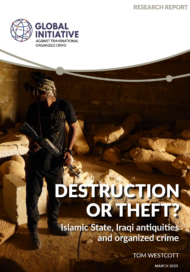Posted on 23 Oct 2025
Early on 19 October 2025, four people disguised as construction workers executed a meticulously planned robbery at the Louvre Museum in Paris. In under 10 minutes, they made off with eight items from the French Crown Jewels collection – pieces renowned for their historical significance and collectively worth an estimated €88 million. Although the perpetrators have not yet been identified, Paris prosecutor Laure Beccuau described the operation as ‘most likely the work of organized crime’.
This latest headline-grabbing heist joins a long list of high-profile European art and antiquities robberies carried out in recent years, each involving different methods and varying intentions but all suggesting organized crime involvement. Earlier this year, for example, criminals used explosives to gain access to the Drents Museum in the Netherlands, stealing several archaeological pieces valued at €6 million, including the Helmet of Coțofenești, a Romanian artefact dating back to 450 BC. Investigators suspect that the operation was carried out by Dutch outlaw motorcycle gangs on behalf of Romanian organized crime groups. In 2019, members of Germany’s notorious Remmo clan cut through reinforced windows to steal 21 pieces of 18th-century Kingdom of Saxony jewellery from the Green Vault museum in Dresden. Only some of these pieces were recovered under a 2022 restitution deal.
Organized crime groups are increasingly targeting art and antiquities held in European collections, drawn by the continent’s cultural repositories and art markets. While many of Europe’s modern-day collections include works taken from beyond the continent, notably from Africa, Asia and Latin America, recent thefts by organized crime have largely targeted European works themselves – many of which will never be recovered – posing a growing threat to the continent’s cultural heritage.
Yet, as with other high-profile museum robberies, the Louvre heist is merely the opening act in a wider illicit process of acquiring, moving and profiting from stolen cultural property. This raises the question of how such iconic pieces are moved and ultimately converted into value once they leave museum custody.
Valuable materials
When it comes to exceptionally famous, well-documented pieces, selling them intact on the black market is risky. Criminals often break them down into raw materials by stripping settings, melting metals and recutting stones. Items with a high proportion of recoverable components – such as gold, silver and gemstones – are especially valuable, as there is less chance of detection when these high-value materials enter the black market.
The 2019 theft of an 18‑carat gold toilet – a work by Italian artist Maurizio Cattelan, titled America – from Blenheim Palace in the UK is believed to be one such case. The work was value valued at US$6 million, and authorities believe that it was melted down. A similar fate appears to have befallen the ‘Big Maple Leaf’, the world’s largest gold coin, which was stolen from Berlin’s Bode Museum in 2017, also by members of the Remmo clan. The Celtic treasure of Manching – a collection of 483 gold coins stolen from a Bavarian museum in 2022 – is similarly presumed to have ended up in a crucible.
Resale is unlikely for iconic, gem-heavy pieces such as the Louvre jewels, making the extraction of precious metals and stones a more feasible way to realize value. This theory is supported by the fact that the thieves curiously left behind items of even greater material value, including the Regent Diamond. This selectivity may indicate a preference for jewels that can be more easily resold, as the most famous stones are instantly recognizable and would require recutting before they could circulate undetected.
If the perpetrators indeed intend to convert the pieces into raw materials, the ongoing manhunt in Paris is time-critical; the longer the items remain at large, the greater the likelihood that they will be rendered permanently unrecoverable.
Strategic assets
Not all criminal groups treat stolen artworks purely as financial assets. Some are used as strategic instruments – collateral, leverage or currency – in the criminal underworld. Prestigious artworks can facilitate agreements or secure loans between criminal groups. During the 1990s, for instance, the Giacomo Medici network smuggled thousands of ancient artefacts from museums and auction houses, incorporating them into their drug and arms trafficking deals. Items stolen by the group continue to be recovered, with pieces worth US$2.2 million recovered in New York in early 2025.
Even when a piece is too famous to sell, it retains value in other ways. In 2020, the Frans Hals painting Two Laughing Boys with a Mug of Beer was stolen from a museum in the Dutch city of Leerdam. A Belgian citizen, who is currently on trial for alleged involvement in cocaine trafficking, is suspected to have acquired the artwork on the black market for €500 000 – a fraction of its estimated €15 million value – weeks later. He intended it as a bargaining chip in case he ever needed to negotiate his partner’s release from prison – a contingency that ironically came into play when both were arrested years later.
Criminals typically reserve this strategy for portable, valuable items that can be concealed and transferred discreetly. While the Louvre jewels may have been stolen for reasons other than monetary gain – whether as collateral, or for status or leverage – this is unlikely given their public profile. What other strategies, then, may have driven the heist?
An expensive shopping list
A third scenario is theft-to-order. Part of the wider ‘crime-as-a-service’ phenomenon – hired hitmen being one example – this occurs when specialists with insider knowledge and honed tradecraft are hired to steal specific items. In 2017, a French antiques dealer was sentenced to seven years in prison for commissioning the theft of Fernand Léger’s Still Life with Candlestick from a Paris art museum in 2010. The thief, nicknamed ‘Spiderman’ for his ability to scale buildings, was sentenced to eight years, after also taking paintings by Matisse, Picasso, Braque, Léger and Modigliani, bringing the total value of the stolen items to over €100 million.
Works stolen on commission rarely re-enter the legitimate market. Instead, they tend to be kept in private collections, circulated among criminal networks, or held for their strategic or material value. Indeed, artworks can also serve as status symbols among criminals. The 2002 theft of two Vincent van Gogh paintings from the Van Gogh Museum in Amsterdam is one possible example. Both pieces remained missing for over a decade, until Italian authorities recovered them in 2016 from Raffaele Imperiale, an Italian mafia boss who claimed to have acquired them for their artistic value.
In a theft-to-order scenario, thieves can bypass many of the problems associated with resale or conversion into raw materials: the buyer is already identified, the logistics are tailored to the specific commission and the reward is guaranteed. While the conversion-into-raw-materials theory remains plausible in the Louvre case, the decision to leave behind items of greater value lends weight to the theft-on-commission hypothesis.
Addressing Europe’s problem
Over the past decade, Europe has seen organized crime assume an increasingly prominent role in high-value commodity theft. In recent years, a spate of robberies has hit world-class museums and smaller collections, with the Louvre heist the latest in this pattern. While public outrage often centres on the loss of Europe’s cultural heritage, organized crime reduces these irreplaceable objects to mere assets – sources of hard currency and raw materials – or symbols of criminal power and defiance of state authority.
Europe’s museums are learning hard lessons about organized crime’s involvement in the theft of cultural artefacts. Understanding of the organized crime-driven market for stolen art and cultural goods is sketchy, and the more high-profile the objects, the opaquer their distribution channels become. Europe must urgently step up efforts to safeguard its cultural heritage and improve its knowledge of this widely misunderstood illicit economy.



